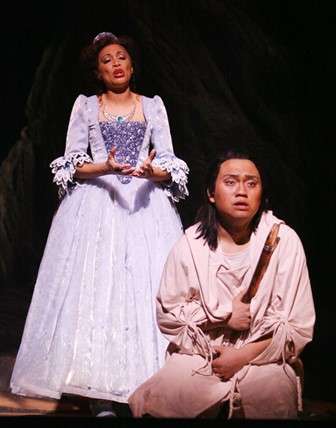|
Back
College-Conservatory’s Zauberflöte Magic Cincinnati
Corbett Auditorium, University of Cincinnati College-Conservatory of Music
04/04/2013 - & April 5, 6, 7*, 2013
Wolfgang Amadeus Mozart: Die Zauberflöte, K. 620
Yi Li (Tamino), Jacqueline Echols (Pamina), Molly Hanes (The Queen of the Night), Stefan Erik Egerstrom (Sarastro), Conor McDonald (Papageno), Ariel Deshotel (Papagena), Jeff Byrnes (The Speaker), Tara Deieso, Jennifer Panara, Leah De Gruyl (The Three Ladies), Spencer Viator (Monostatos), Jason Weisinger, César A. Méndez Silvagnoli (Two Priests), Natalie Eccleston, Elizabeth A. Orsborn, Adria Caffaro (Three Genii), M. Andrew Jones, Thomas Richards (Armored Men)
CCM Philharmonia Orchestra, Mark Gibson (conductor)
Steven Goldstein (director), Ryan Howell (scenic designer), Dean Mogle (costume designer), Kelly Yurko (wig and make-up designer), David LaRose (lighting designer), Zachary Ireson (sound designer), Marie-France Lefebvre (musical preparation), Jahana Azodi (stage manager)

J. Echols & Y. Li (© Mark Lyons)
It is all too easy to describe an opera production as “magic,” but for the University of Cincinnati College-Conservatory of Music’s Die Zauberflöte (The Magic Flute) April 7 in Corbett Auditorium, the adjective fit. From singing and acting to set design and costumes, there was a bit of enchantment in everything. Sung in German with English dialogue and captions, it featured an all-student cast and a student production staff. The conductor and director were Mark Gibson and Steven Goldstein of the CCM faculty, as was costume designer Dean Mogle and wig and makeup designer Kelly Yurko.
The action transpired in a large room, vacant except for a tree growing out of the floor. There were three doors at the back (entrances to Sarastro’s temple) and a fireplace with a mirror above it. As scenes changed, huge paintings were flown in – digitally edited from classic originals by student scenic designer Ryan Howell – to suggest Pamina’s bedroom, Sarastro’s temple, the trial scenes, etc.
The time? Anytime and no time, with costumes ranging from priestly to cone-headed aliens (the Three Genii). The Queen of the Night and her Three Ladies wore dark blue gowns and makeup, befitting their nocturnal image. The leather-jacketed Monastatos had a black snake tattooed on his chest. Bearded and regal, Sarastro wore the disc of the sun on his robe. Pamina might have been an 18th-century lady in a long, formal gown, while Tamino was an Asian prince. Papageno, Mozart’s feathered, comical sidekick, had a red nose like a clown.
The curtain rose on Tamino and the serpent, the latter comprising five actors, each bearing a segment of the scrap-heap, pop-eyed beast. The Three Ladies clapped a star-shaped lock over Papageno’s mouth for claiming to have killed the serpent. As Tamino admired the locket bearing Pamina’s portrait -- thereby falling instantly in love -- the Queen of the Night made her appearance through the mirror over the fireplace.
Clearly anything could happen in this fanciful world, and it did. The Three Genii descended in gilt-edged chairs to help Tamino and Papageno rescue Pamina from Sarastro. Tamino summoned a set of anomalous creatures outside Sarastro’s palace with his magic flute. Papagena hatched from a big blue egg that rose through the trap door. In the final scene, the tree was cut away and bright sunlight engulfed the stage. The trials of fire and water (Tamino and Pamina) were unfortunately left to the imagination, however, with tenor Yi Li and soprano Jacqueline Echols peering into a book that streamed light as the music told the story.
All of this took place in the context of Mozart’s glorious music, given a splendid reading by the student cast and the CCM Philharmonia led by Gibson. Li and Echols were a well-matched couple as Tamino and Pamina, with strong, burnished voices and fine acting skills. Molly Hanes as the Queen of the Night displayed an agile, silvery voice, nailing her high notes with admirable precision. Bass Stefan Erik Segerstrom as Sarastro, who must sound extremely low notes, projected nobility and warmth. Baritone Conor McDonald stole the show as Papageno, not only for his fine vocalism, but for his boffo comedic acting and the best diction onstage. Tenor Spencer Viator as the moor Monostatos, no stereotype, made an impressive villain.
Vocal highlights (many) included Li’s “Bildnis ist bezaubernd schön,” expressing his rapture over Pamina’s portrait, and Echols’ grief stricken “Ach, ich fühl’s, es ist verschwunden,” when Tamino, constrained by his vow of silence, will not speak to her. McDonald was delightful in Papageno’s “suicide” scene and with soprano Ariel Deshotel (Papagena) in their irresistible patter aria. The Three Ladies and Three Genii inhabited their roles with conviction and skill, and communication between the stage and the pit was exemplary throughout.
College-Conservatory of Music, University of Cincinnati
Mary Ellyn Hutton
|